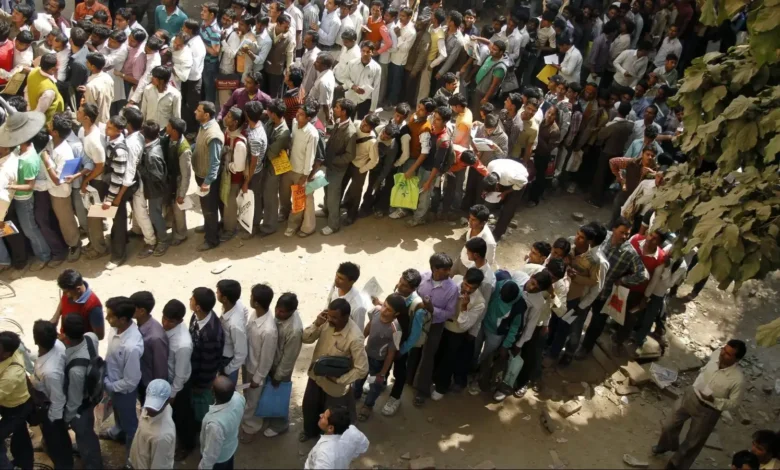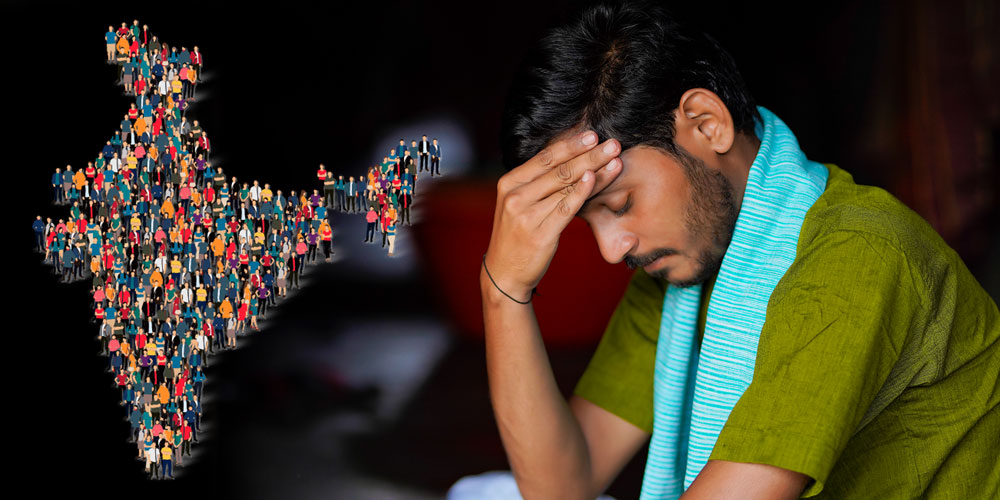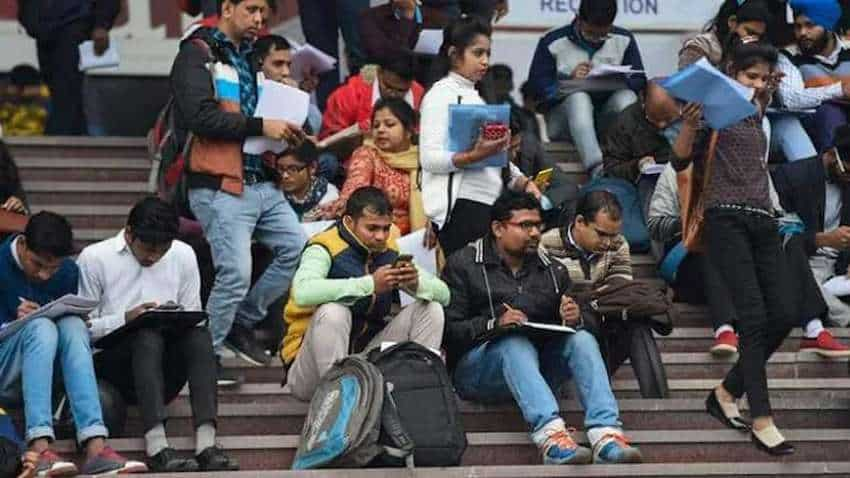Union Labour Minister Mansukh Mandaviya Assures, “There Is No Unemployment, No Need To Worry About Jobs.” So Why Are Hundreds Appearing For A Handful Of Vacancies?
During a session in the Lok Sabha Union, Labour Minister Mansukh Mandaviya recently addressed concerns about job losses in India, assuring that the unemployment rate is steadily declining. At the same time, he spoke about the government's efforts to create more jobs. However, despite the optimistic assurance, surveys and expert opinions suggest that many young Indians still struggle to find employment, pointing to deeper issues within the country's job market.

Let’s see what the number one challenge India faces in the long list of challenges (crumbling infrastructure, dwindling law and order, judicial reform, women’s safety, inflation, etc.) is: unemployment!
Yet, Union Labour Minister Mansukh Mandaviya announced that there is no need to worry about job losses in India.
Speaking in the Lok Sabha, he said the country aims to lower the unemployment rate to below 3% soon; the current rate has already dropped from 6% in 2017-18 to 3.2%.
If that is actually the case, then it is surprising to see episodes where hundreds line up for a handful of vacancies!
But hold on, Mandaviya credited this drop to job creation efforts under Prime Minister Narendra Modi’s government.
He pointed out that the labour force participation rate increased from 38% in 2017-18 to 44%, and the work-population ratio rose from 31% to 40% in the same period.
“There is no need for concern about job losses, and there is no lack of jobs,” Mandaviya added.
Do Statistics Lie?
India’s economic growth exceeded 8% in the first three quarters of 2023-24, surpassing optimistic projections.
However, a Lokniti-CSDS survey of Delhi’s youth shows that 80% of respondents found it difficult or very difficult to get a job in the last two years. This suggests that India’s growth is not translating into enough job opportunities for young people.
Jobs are the number one economic and social issue.
The working-age population makes up about 63% of India’s total population and is expected to stay that way for a while. This period, known as the demographic window, is crucial for economic transformation, as seen in East Asian tiger economies; hence, missing this opportunity could lead to stagnation.
India has faced low job creation over the past decade, with the worker-to-population ratio dropping from 38.6% in 2011-12 to 37.3% in 2022-23, according to government labour surveys.
The government has struggled to create jobs for unskilled and poor workers, with only 20% of Indians working in manufacturing or IT services, while over 40% remain in agriculture, according to the UN University World Institute for Development.
Additionally, Indian economist Jayati Ghosh notes that the benefits of India’s economic growth have been unequally distributed among the top 10-20% of income earners.
The unemployment crisis is especially felt by the 8 million young and educated Indians entering the workforce each year, challenging the belief that education guarantees a job.
According to a recent report from the International Labor Organization (ILO), 83% of India’s unemployed are young, and 66% are both young and educated.
Surprisingly, those without university degrees or even full schooling have a higher employment rate. This results in what the ILO calls “paradoxical improvements” in India’s labor participation rate, workforce participation rate, and unemployment rate.
However, these numbers are hard to measure accurately because the government hasn’t released consumption figures from consumer expenditure surveys, which are usually done every five years.
“In India, a large part of the workforce is in the informal sector, meaning many work without contracts, social security, insurance, or are self-employed,” says Ranade.

49,000 MSME Closed Down Over 10 Years, 3 Lakh Jobs Lost
In the last 10 years, nearly 50,000 small businesses have closed, causing over 300,000 people to lose their jobs, according to government data.
Minister for micro, small, and medium enterprises (MSMEs) Jitan Ram Majhi told the Lok Sabha that out of a million registered MSMEs, 49,342 have shut down, resulting in 317,641 job losses. This is from a total MSME workforce of 181.6 million registered on the Udyam portal since its launch on July 1, 2020.
Majhi noted that 0.17% of enterprises, employing 317,641 people, have de-registered or closed in the past ten years.
The latest annual PLFS reports show the estimated unemployment rate for people aged 15 and above was 4.2% in 2020-21, 4.1% in 2021-22, and 3.2% in 2022-23.
Maharashtra saw the most closures with 12,233 MSMEs shutting down, leading to 54,053 job losses. This was followed by Tamil Nadu (6,298 closures, 43,324 job losses), Uttar Pradesh (3,425 closures, 33,230 job losses), Gujarat (4,861 closures, 22,345 job losses), and Bihar (2,414 closures, 15,317 job losses).
Madhya Pradesh, governed by the BJP for over 19 years, has seen 1,653 MSME units close, resulting in 11,727 job losses.
The minister explained to the House, “These closures are due to various reasons, including changes in company ownership, redundant certificates, and duplicate registrations.”
In Delhi, 947 closures led to the loss of 8,210 jobs, West Bengal had 1,548 closures affecting 8,856 jobs, and Kerala saw 1,336 closures resulting in 12,672 jobs lost.

MSMEs contribute about 45% to India’s total exports
Currently, MSMEs contribute about 45% to the country’s total exports, according to a Global Trade Research Initiative (GTRI) report and experts believe there is significant potential to increase this share.
A March report by NITI Aayog and the Foundation for Economic Development stressed that exports are an underutilized opportunity for MSMEs.
Yet, despite being a major driver of employment, exports, and economic growth, only 0.95% of MSMEs are involved in exporting of the 15.8 million MSMEs registered on the Udyam portal, only over 150,000 units export their goods and services.
Data from GTRI shows that India lags behind China significantly in e-commerce exports. In 2022, Chinese MSMEs exported goods worth over $200 billion through e-commerce platforms, while India’s e-commerce exports were barely $2 billion.
According to commerce ministry data, the focus on MSME exports has increased as India’s merchandise exports dipped 3.11% year-on-year in FY24 to $437.06 billion.
MSMEs contribute about 27% to India’s GDP and employ more than 110 million people, making them the country’s second-largest employer after agriculture.
In her budget speech, Finance Minister Nirmala Sitharaman announced several measures to boost the MSME sector.
The budget emphasized financial and technological support, including a credit guarantee scheme for machinery loans without collateral, a self-financing guarantee fund offering up to ₹100 crore per borrower, and a new assessment model for MSME credit by public sector banks based on digital footprints.
Additionally, the budget proposed enhanced credit support during stress periods to prevent MSMEs from becoming NPAs, raising the Mudra loan limit to ₹20 lakh, and planning to open 24 new SIDBI branches in MSME clusters within three years.
E-commerce export hubs will also be established in a PPP mode to help MSMEs and traditional artisans access international markets with a seamless regulatory framework.

Measures Taken By The Govt
Mandaviya’s assurance regarding unemployment followed Finance Minister Nirmala Sitharaman’s announcement of three major schemes to boost employment.
One of these is a first-time employment scheme, which will offer one month’s wage to new workforce entrants across all sectors, potentially benefiting 2.1 crore youths.
Under this scheme, a direct benefit transfer of one month’s salary, up to Rs 15,000, will be provided in three installments, with an eligibility limit of Rs 1 lakh monthly salary.
Employers will also be reimbursed Rs 3,000 per month towards Employees’ Provident Fund Organization (EPFO) contributions for two years for each additional employee. This initiative aims to add 50 lakh new jobs and benefit 30 lakh youth.
Support for Skill Development and Higher Education
Additionally, the Model Skill Loan Scheme has been revised to allow loans up to Rs 7.5 lakh with a government-backed guarantee fund, benefiting 25,000 students annually.
The government will also support higher education loans up to Rs 10 lakh for domestic institutions, with 1 lakh students receiving e-vouchers each year. These measures are part of the broader effort to enhance skill development and provide better employment opportunities for the youth.
Challenges in the Job Market, The Big Picture
After the Covid-19 pandemic, the economy bounced back sharply, and unemployment fell. However, two negative trends emerged in the job market.
Many people moved back to agriculture, which means limited earnings. Additionally, many new jobs were in the unstable category of self-employment, especially for women.
These challenges were spotlighted in a recent jobs report based on government data by the ILO and the Institute for Human Development.

Youth Employment Crisis
India’s youth employment situation suggests a crisis.
The share of youth who are not in employment, education, or training averaged 29.2% between 2010 and 2019, the highest in South Asia.
There is a high proportion of unemployed educated youth, even as industries complain of a shortage of skilled labor. Except for a few elite institutions, education in India does not guarantee employability.
For example, about 3,700 PhDs recently applied for the post of a peon in UP police, where the eligibility criterion was Class V education.
Women Not Wanted in the Job Market
The job market’s message to women is clear: they are not wanted.
No surprise then that if 53.2% of the female workforce was self-employed in 2019, the proportion increased to 62% in 2022. Many of these women are not even paid.
Stagnant Earnings
Over the past decade, the average monthly inflation-adjusted earnings of regular salaried and self-employed individuals have either declined or remained stable. This is reflected in the weak consumption data despite GDP growth exceeding 8%.
Indian Voters Saw Job Creation as the Biggest Election Issue
As India’s marathon election kicked off, unemployment was a major concern for millions of voters, despite the country’s rapid economic growth.
Since Indian Prime Minister Narendra Modi came to power in 2014, economists have touted India as a powerful rival to China, particularly in global manufacturing, investment, and growth capabilities.
Investors have reason to be optimistic: between 2014 and 2023, India’s GDP grew by 55%, surpassing the U.K., France, Italy, and Brazil to become the world’s fifth-largest economy.
The IMF projects a 6.3% expansion this year—a significant achievement for a trillion-dollar economy.
Despite India’s young population, there is a concerning lack of necessary skills among the workforce.
A report highlights that many young people lack basic digital literacy skills, hindering their employability. For instance, 90% of Indian youth cannot put a mathematical formula into a spreadsheet, 60% cannot copy and paste files, and at least 75% cannot send emails with attachments.
The report also spotlights the widening gender gap in the labour market, with low rates of participation by the female labour force.
Young women, particularly those with higher education, face significant challenges in securing employment.
The Last Bit, Despite the optimism shown by the latest speech on unemployment, the reality is very different on the ground.
To provide jobs for its increasingly educated youth, India needs even faster economic growth, and this growth must be labour-intensive.
This approach will generate demand in the economy from all sections of society, not just the middle class and above.





